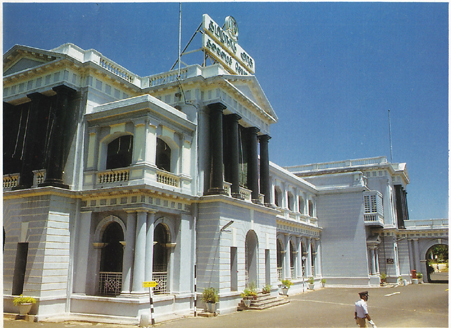|
In the ongoing exchanges over the new Assembly-cum-Secretariat versus the old one at Fort St George, several ingenious contentions and reasons are being put forward by both sides.
The latest and perhaps the most laughable one postulated by those who want the shift to be made to the new building is that the Fort is a symbol of British imperialism and so ought not to be the home of the State Government. All we can say to that is that it has taken more than 65 years for this wisdom to dawn. And at the end of such a long period, does it matter any longer?
 Fort St. George, built by Tamil artisans with Tamizhagam materials. |
If Fort St George is indeed a symbol of British imperialism, by the same token we ought to be abandoning a number of other buildings. The High Court, the Central and Egmore Railway Stations, the General Hospital, the Madras Medical College, the Guindy Engineering College, Senate House… the list is practically endless. Of course, by doing so, we would make the real estate lobby very happy but we would be much poorer at the end of it all. Even Madras that is Chennai is a creation of the British. So, does that mean we must abandon the city lock, stock and barrel? What of our Constitution and our systems of bicameral legislature? Are these not based on Western models? Should we discard them whimsically?
And what of earlier imperialism? Our Prime Minister still unfurls the national flag on Independence Day at the Red Fort, which is the symbol of the subjugation of India by the Mughals. So, does this logic in the case of Fort St George hold water?
What is also interesting is that those who put forward this argument have been in power at Fort St George at least from the late 1960s. Is it, therefore, a case of post facto reasoning and justification?
Let’s face it. Most edifices of power in India were constructed in the period before Independence. Rashtrapati Bhavan, Parliament House, several gubernatorial residences, State Assemblies and High Courts of Judicature are all Raj period structures and we are none the worse for it by continuing to use them. And even in instances where the shift has been made to modern buildings, the reasons have been purely convenience-oriented, with the older structure being taken care of.
Now let us look at the new Assembly building and see how Indian it is. Designed by German architects, it has virtually no bearing on any Indian element of architecture, no matter how many reams have been written towards explaining the essential Indian-ness in the design. And if the argument is made out that the new building was built by Tamil-speaking artisans, let us correct it to point out that the bulk of the labour came from North India. More Hindi was heard on the site than at a conference of pundits. As for the materials used, how much was Indian or true to traditional Indian materials? At least, Fort St George when it was built used local labour, guided by native maistries who would have worked under British garrison engineers. And it was local brick and lime and granite that were used.
The fundamental argument for ensuring that the new building is used should be that Rs. 1000 crore of public money has been spent on its construction.
Abandoning such a structure would be a dangerous precedent, for it would mean that in future too money on such a scale can be spent without any thought of the end-benefit.
Let those in power (and out of it) think on how the building should be best used in the circumstances. Why not as home to various government departments and quasi-Government organisations now in rented buildings?
|